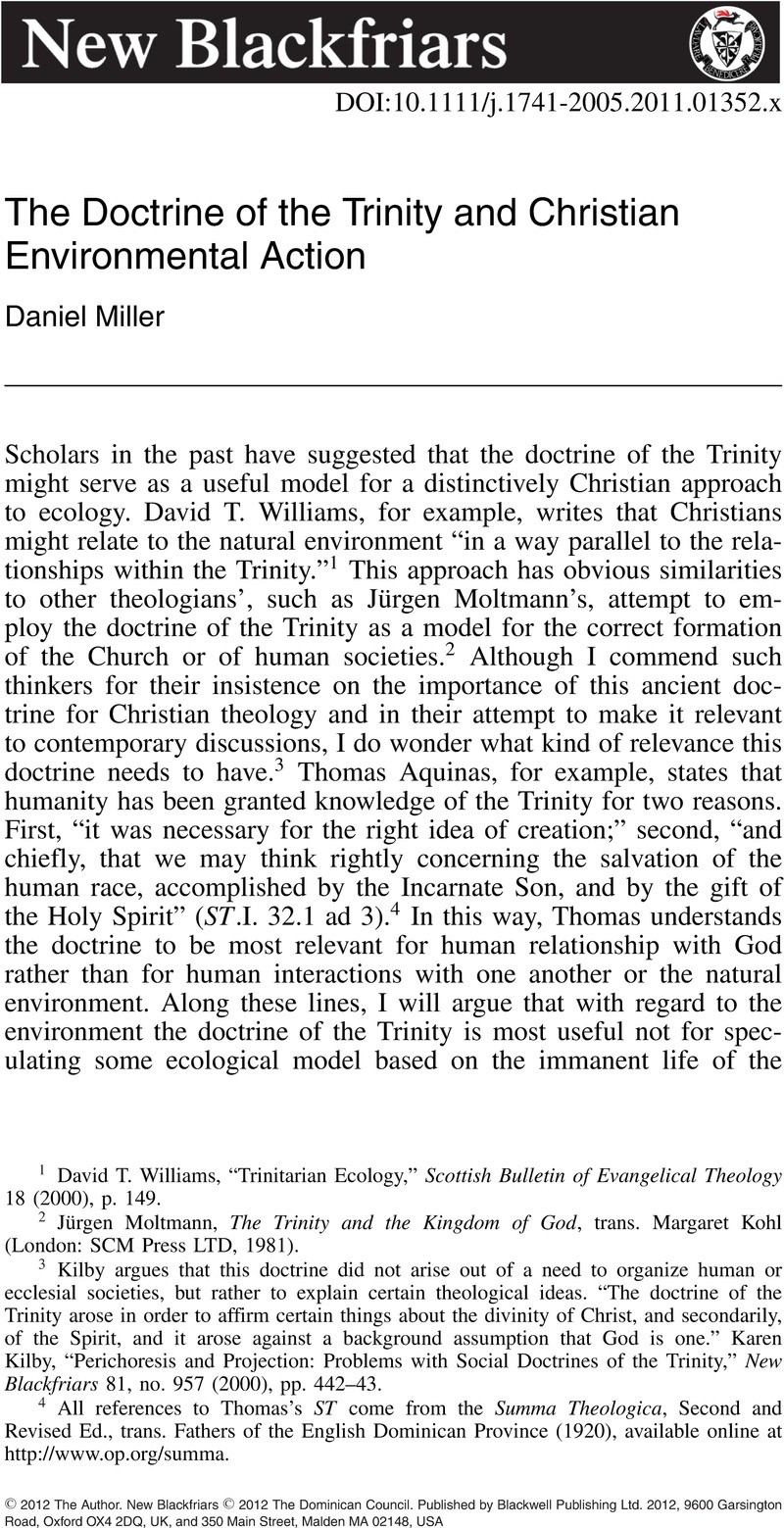Article contents
The Doctrine of the Trinity and Christian Environmental Action
Published online by Cambridge University Press: 01 January 2024
Abstract

- Type
- Original Articles
- Information
- Copyright
- Copyright © 2012 The Author. New Blackfriars © 2012 The Dominican Council
References
1 Williams, David T., “Trinitarian Ecology,”Scottish Bulletin of Evangelical Theology 18 (2000), p. 149Google Scholar.
2 Moltmann, Jürgen, The Trinity and the Kingdom of God, trans. Kohl, Margaret (London: SCM Press LTD, 1981Google Scholar).
3 Kilby argues that this doctrine did not arise out of a need to organize human or ecclesial societies, but rather to explain certain theological ideas. “The doctrine of the Trinity arose in order to affirm certain things about the divinity of Christ, and secondarily, of the Spirit, and it arose against a background assumption that God is one.”Kilby, Karen, “Perichoresis and Projection: Problems with Social Doctrines of the Trinity,”New Blackfriars 81, no. 957 (2000), pp. 442–43CrossRefGoogle Scholar.
4 All references to Thomas's ST come from the Summa Theologica, Second and Revised Ed., trans. Fathers of the English Dominican Province (1920), available online at http://www.op.org/summa.
5 Williams, “Trinitarian Ecology,” p. 142.
6 Ibid., p. 146.
7 Behr, John, “The Trinitarian Being of The Church,”St. Vladimir's Theological Quarterly 48.01 (2004), p. 68Google Scholar.
8 Emery, Giles, Trinity in Aquinas (Ypsilanti, MI: Sapientia Press, 2003), p. 132Google Scholar.
9 Here I am modifying Miroslav Volf's statement that a social model based on the doctrine of the Trinity “reduces theology to anthropology or, in a reverse fashion, elevates anthropology to theology.” Volf, Miroslav, After Our Likeness (Grand Rapids, MI: William B. Eerdmans Pub., 1998), p. 198Google Scholar.
10 Emery, Trinity in Aquinas, p. 131.
11 Williams, “Trinitarian Ecology,” p. 149.
12 Tertullian, , Adversus Praxean Liber, trans. Evans, Ernest, (London: S.P.C.K, 1948), p. 139Google Scholar.
13 Ibid., p. 140.
14 Augustine, , De Trinitate, trans. Hill, Edmund (Hyde Park, NY: New York City Press, 1991), p. 428Google Scholar.
15 Ibid., p. 399. Italics original.
16 Ibid., p. 426.
17 Williams, “Trinitarian Ecology,” p. 149.
18 Emery, , “Trinity and Creation\,” in The Theology of Thomas Aquinas, ed. Nieuwenhove, Rik Van and Wawrykow, Joseph (Notre Dame, IN: University of Notre Dame Press, 2005), p. 71Google Scholar.
19 Ibid.
20 Ibid., p. 62.
21 Williams, “Trinitarian Ecology,” p. 152.
22 “Because the similitude of this [divine] goodness could be impressed more perfectly in creation only if there was a diversity and a plurality of things, there had to be a plurality of forms which constitute different species.” Blanchette, Oliva, The Perfection of the Universe According to Aquinas: A Teleological Cosmology (University Park, PA: Pennsylvania State University Press, 1992), p. 173Google Scholar.
23 St. Gregory of Nazianzus, The Second Theological Oration – On God, trans. Browne, Charles Gordon and Swallow, James Edward, in Christology of the Later Fathers (Louisville: Westminster John Knox Press, 1954), p. 155Google Scholar.
24 Ibid.
25 Jenkins, Willis, Ecologies of Grace: Environmental Ethics and Christian Theology (Oxford Scholarship Online, 2009), p. 131Google Scholar.
26 Ibid. Blanchette relates this idea to Thomas's notion of the perfection of the universe: For the universe, as for a house or the human body, “perfection of completion would be lacking if all parts were the same and served the same function.” Blanchette, Perfection of the Universe, p. 124.
27 Speaking of animal agriculture, Edward Price notes that the “tendency to breed and subsist on but a few preferred and competitive species” is a questionable practice, but one that fits “into current patterns of trade and [has] clearly understood market value.” Price, Edward O., Animal Domestication and Behavior (New York: CABI Pub., 2002), p. 6CrossRefGoogle Scholar.
28 Along these lines, Colin Gunton claims that the various creatures in the natural world are gifts of the God the Spirit that the question humans should ask with regard to our actions toward them is, “Does this offer to God the creator the sacrifice of praise of the perfected creation?” Gunton, Colin E., The Triune Creator: A Historical and Systematic Study (Edinburgh: Edinburgh University Press, 1998), p. 231Google Scholar.
29 Miroslav Volf, “After Our Likeness,” p. 194.
30 Newbigin, Lesslie, Trinitarian Doctrine for Today's Mission (Eugene, OR: Wipf & Stock Pub., 1988), p. 83Google Scholar.
31 Thompson, John, Modern Trinitarian Perspectives (New York: Oxford University Press, 1994), p. 70CrossRefGoogle Scholar.
32 Northcott, Michael S., The Environment and Christian Ethics (Cambridge: Cambridge University Press, 1996), p. 203CrossRefGoogle Scholar.
33 Ibid., p. 204.
34 O’Donovan, Oliver, Resurrection and Moral Order (Leicester: Inter‐Varsity Press, 1986), p. 14Google Scholar.
35 Ibid..
36 “If dominion is defined for Christians by Jesus, then we cannot avoid the sacrificial element in the imaging of God into which, as Jesus’‘body,’ we are being incorporated.” Hall, Douglas John, Imaging God: Dominion as Stewardship (New York: Wm. B. Eerdmans Pub. Co., 1986), p. 195Google Scholar.
37 DeWitt, Calvin, “Epilogue” in The Environment and the Christian: What Can We Learn from the New Testament?, ed. DeWitt, Calvin (Grand Rapids, MI: Baker Book House, 1991), p. 111Google Scholar.
38 Ibid., p. 113.
39 Newbigin, Trinitarian Doctrine, p. 83.
40 Ibid., p. 80.
41 Williams, “Trinitarian Ecology,” p. 149.
- 1
- Cited by


